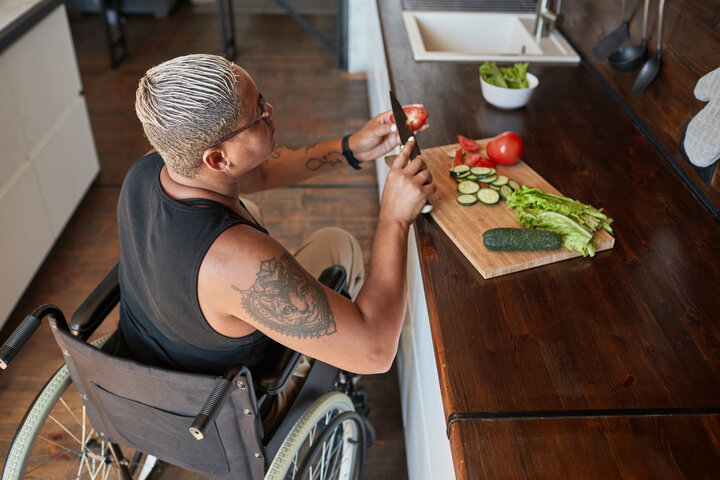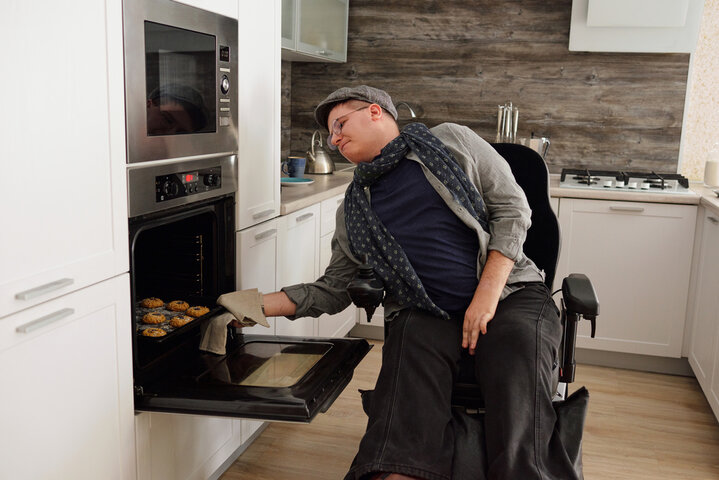
When Healthy Food Isn’t Accessible: The Overlooked Struggle for People with Disabilities
May 13, 2025
Jia Li, PhD
Edited by:
Raquel Minarsch,
Ceren Yarar-Fisher, PhD
Everyone Deserves Access to Nutritious Food—But Not Everyone Has It
Access to nutritious food is a basic human right. It’s not just about having enough to eat—it’s about having the right kinds of food: fresh, safe, and nourishing meals that support your health, help prevent disease and allow you to live fully and independently. This idea is called nutrition security—having consistent access to healthy food that meets your personal needs, both now and in the long term.
But for many people with disabilities, this right is still out of reach.

Why Are People with Disabilities More at Risk?
People with disabilities are more likely to experience both food insecurity—not having enough to eat—and nutrition insecurity—not having access to the kinds of foods that support good health. This isn’t just a matter of bad luck. It’s largely due to how disability intersects with what are known as social determinants of health—the everyday factors that shape a person’s health and well-being. These include things like income, education, neighborhood safety and accessibility, access to healthcare, and the strength of one’s social and community networks
When these factors are out of balance—as they often are for people with disabilities—they create barriers that make it harder to eat well.

Financial Strain: Healthy Food Comes at a Cost
Eating healthy can be expensive. For individuals with disabilities, limited job opportunities, disability-related work restrictions, and benefit eligibility limits can mean lower income. At the same time, they often face higher healthcare costs, leaving less money to spend on healthy options, such as fresh produce, lean proteins, or whole grains—which are often more expensive than processed, packaged foods.

Physical Barriers: Getting to and Around the Store
For many people with disabilities, transportation is the first physical barrier to food access. Public transit often doesn’t stop near grocery stores, and rideshare services may not be accessible. Modifying a personal vehicle with ramps, hand controls, or lifts can cost thousands of dollars—putting reliable transportation out of reach for many. The grocery store environment itself can pose challenges. Narrow aisles, high shelves, and checkout counters that aren’t wheelchair-friendly make shopping physically difficult and sometimes unsafe. Back at home, most kitchens aren’t designed for accessibility, and making adjustments—like lowering counters or purchasing adaptive cooking tools—can be expensive.
Because of these hurdles, some people are forced to rely on what’s nearby or easy—convenience stores or delivery services that often don’t offer the healthiest options.

Loss of Independence: Who Chooses the Food?
Some people with disabilities depend on caregivers or aides to help with shopping and meal preparation. While that support is vital, it also means giving up a degree of independence. Caregivers might make quick decisions based on what’s easiest or what they personally prefer—not necessarily what’s healthiest for the person they’re helping. Tight schedules can also prevent cost-saving strategies like comparing prices or using coupons, making it even harder to stay within budget while eating well.

And That’s Not All…
These are just a few of the many challenges people with disabilities may face. Other factors—like uneven or inaccessible sidewalks, living in rural areas with limited store options, or not having access to clear, reliable nutrition information—can make things even more complicated. One thing is clear: food access looks different for everyone, and the solutions must be just as diverse.
What Can We Do Moving Forward?
Create Better Resources: Nutrition should be easy to understand and act on. That means creating easy-to-read nutrition guides, inclusive cooking classes, and offering online tutorials or recipe booklets that meet a wide range of needs and abilities.
Advocate for Stronger Support: With food assistance programs under pressure, it’s more important than ever to protect and expand benefits for people who need them. This includes programs like SNAP (Supplemental Nutrition Assistance Program), Meals on Wheels, and the USDA’s Commodity Supplemental Food Program (links below). Local and state-level programs also need support—such as community gardens, mobile food markets, and food delivery options tailored for people with disabilities.
Center the Voices of People with Disabilities: Too often, solutions are designed without including the people they’re meant to serve. We must include people with disabilities in conversations about food access, listen to their experiences, and ensure their voices shape the policies and programs designed to help.
Resources
(Underscored text can be clicked to visit the corresponding webpages. We are not affiliated with any external sources except when specified.)
Nutrition & Cooking Support
- We developed a quick guidebook on a healthy lower-carbohydrate high
- More cookbooks with 5 ingredients or less, budget-friendly healthy recipes
- Accessible cooking tools tested
Food Assistance Programs
- SNAP (Supplemental Nutrition Assistance Program): Monthly grocery benefits to help individuals and families afford healthy food.
- The Emergency Food Assistance Program (TEFAP): Free food distributed through local food pantries to those in need.
- Commodity Supplemental Food Program (CSFP): Monthly food boxes for low-income adults aged 60 and older.
- Meals on Wheels for Seniors: Nutritious, home-delivered meals for older adults and individuals with disabilities.
- Mid-Ohio Food Collective: Find out if you're eligible to receive free, healthy groceries through community markets and food pantries.